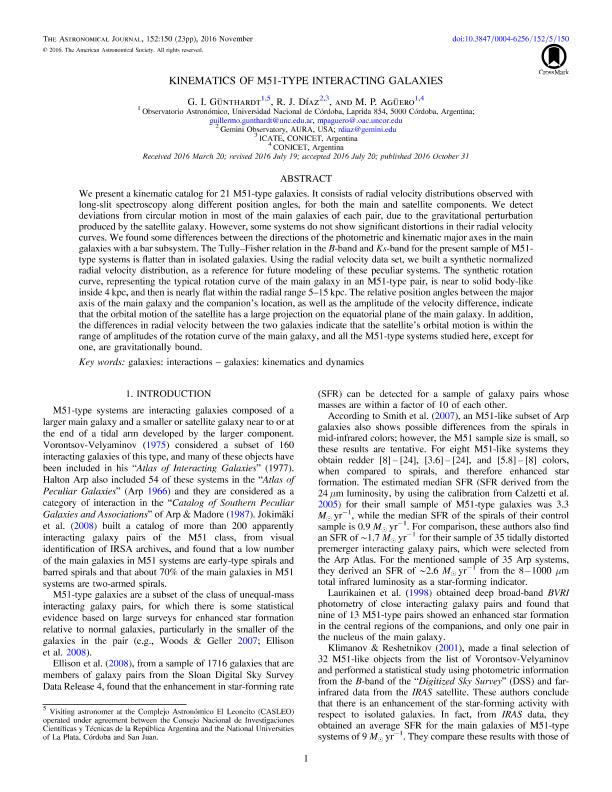Mostrar el registro sencillo del ítem
dc.contributor.author
Gunthardt, Guillermo Ivan

dc.contributor.author
Diaz, Ruben Joaquin

dc.contributor.author
Agüero, Maria Paz

dc.date.available
2018-10-11T13:53:09Z
dc.date.issued
2016-11
dc.identifier.citation
Gunthardt, Guillermo Ivan; Diaz, Ruben Joaquin; Agüero, Maria Paz; Kinematics of M51-type interacting galaxies; IOP Publishing; Astronomical Journal; 152; 5; 11-2016; 1-23
dc.identifier.issn
0004-6256
dc.identifier.uri
http://hdl.handle.net/11336/62162
dc.description.abstract
We present a kinematic catalog for 21 M51-type galaxies. It consists of radial velocity distributions observed with long-slit spectroscopy along different position angles, for both the main and satellite components. We detect deviations from circular motion in most of the main galaxies of each pair, due to the gravitational perturbation produced by the satellite galaxy. However, some systems do not show significant distortions in their radial velocity curves. We found some differences between the directions of the photometric and kinematic major axes in the main galaxies with a bar subsystem. The Tully-Fisher relation in the B-band and Ks-band for the present sample of M51-type systems is flatter than in isolated galaxies. Using the radial velocity data set, we built a synthetic normalized radial velocity distribution, as a reference for future modeling of these peculiar systems. The synthetic rotation curve, representing the typical rotation curve of the main galaxy in an M51-type pair, is near to solid body-like inside 4 kpc, and then is nearly flat within the radial range 5-15 kpc. The relative position angles between the major axis of the main galaxy and the companion's location, as well as the amplitude of the velocity difference, indicate that the orbital motion of the satellite has a large projection on the equatorial plane of the main galaxy. In addition, the differences in radial velocity between the two galaxies indicate that the satellite's orbital motion is within the range of amplitudes of the rotation curve of the main galaxy, and all the M51-type systems studied here, except for one, are gravitationally bound.
dc.format
application/pdf
dc.language.iso
eng
dc.publisher
IOP Publishing

dc.rights
info:eu-repo/semantics/openAccess
dc.rights.uri
https://creativecommons.org/licenses/by-nc-sa/2.5/ar/
dc.subject
Galaxies: Interactions
dc.subject
Galaxies: Kinematics And Dynamics
dc.subject.classification
Astronomía

dc.subject.classification
Ciencias Físicas

dc.subject.classification
CIENCIAS NATURALES Y EXACTAS

dc.title
Kinematics of M51-type interacting galaxies
dc.type
info:eu-repo/semantics/article
dc.type
info:ar-repo/semantics/artículo
dc.type
info:eu-repo/semantics/publishedVersion
dc.date.updated
2018-09-27T20:23:04Z
dc.journal.volume
152
dc.journal.number
5
dc.journal.pagination
1-23
dc.journal.pais
Reino Unido

dc.journal.ciudad
Londres
dc.description.fil
Fil: Gunthardt, Guillermo Ivan. Consejo Nacional de Investigaciones Científicas y Técnicas; Argentina. Universidad Nacional de Cordoba. Observatorio Astronomico de Cordoba; Argentina
dc.description.fil
Fil: Diaz, Ruben Joaquin. Consejo Nacional de Investigaciones Científicas y Técnicas. Centro Científico Tecnológico Conicet - San Juan. Instituto de Ciencias Astronómicas, de la Tierra y del Espacio. Universidad Nacional de San Juan. Instituto de Ciencias Astronómicas, de la Tierra y del Espacio; Argentina. Gemini Observatory; Estados Unidos
dc.description.fil
Fil: Agüero, Maria Paz. Consejo Nacional de Investigaciones Científicas y Técnicas; Argentina. Universidad Nacional de Cordoba. Observatorio Astronomico de Cordoba; Argentina
dc.journal.title
Astronomical Journal

dc.relation.alternativeid
info:eu-repo/semantics/altIdentifier/doi/https://dx.doi.org/10.3847/0004-6256/152/5/150
dc.relation.alternativeid
info:eu-repo/semantics/altIdentifier/url/http://iopscience.iop.org/article/10.3847/0004-6256/152/5/150/meta
Archivos asociados
